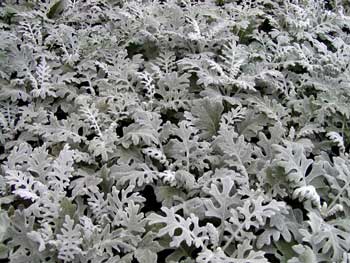Dusty Miller
Senecio cineraria
 |
Common name: Dusty Miller
Latin Name: Senecio cineraria
Design Tip: Dress up the front yard for the holidays with silvery foliage. Use against evergreens or to accent winter annuals in pots or beds. When cool season annuals succumb to summer, the Dusty Miller plants can be left to grow into larger perennials.
Form: Used as seasonal transition filler in mild climates, and as a warm season annual in severe winter regions, this woody-stemmed plant is actually a perennial small shrub in its native subtropical regions.
Size: In mild winter climes, an installation of plants in four-inch pots will grow into 6 to 12 inch rosettes in the first year.
Flowers: A sparse amount of insignificant yellow flowers are produced in the second year. Remove the flowering stems to maintain attractive foliage and prevent stem dieback.
Maintenance: To maintain a bushier plant, remove the center or top growth in the first summer and the bloom stalks in subsequent years.
Cultivation: Good drainage is crucial for winter survival. Once established, it is very heat and drought tolerant, and adaptable to wide range of soil types if well drained to avoid root rot. It thrives in hot, dry conditions, and in sun or partial shade.
Hardiness: Hardy in USDA Zones 7-9, it over-winters in the southern half to two-thirds of Texas.
Snippets: The silver foliage is especially attractive in flower arrangements with red and white blooms for the winter holidays. There are several named cultivars of the above Senecio cineraira and at least six different plants that go by the nickname of Dusty Miller. It belongs to the groundsel or ragwort family, of which there are nearly 900 different known species. It can also be referred to by the following Latin names; Cineraria maritime, Senecio candicans and S. maritimus. The word Cineraria means ashy gray. The species takes its name from the Latin for old man, Senex, alluding to the white hairy leaves.
Cultivated, photographed and written by
Maggie Ross McNeely in Ft. Worth, Texas
All rights reserved